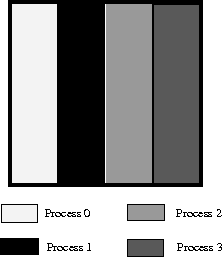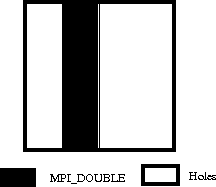


Assume we are writing out a 100x100 2D array of double
precision floating point numbers that is
distributed among 4 processes such that each process has a block of
25 columns (e.g., process 0 has columns 0-24, process 1 has columns
25-49, etc.; see Figure 28
).
To create the filetypes for each process one could
use the following C program
(see Section Subarray Datatype Constructor
on
page Subarray Datatype Constructor
):
double subarray[100][25];
MPI_Datatype filetype;
int sizes[2], subsizes[2], starts[2];
int rank;
MPI_Comm_rank(MPI_COMM_WORLD, &rank);
sizes[0]=100; sizes[1]=100;
subsizes[0]=100; subsizes[1]=25;
starts[0]=0; starts[1]=rank*subsizes[1];
MPI_Type_create_subarray(2, sizes, subsizes, starts, MPI_ORDER_C,
MPI_DOUBLE, &filetype);
Or, equivalently in Fortran:
double precision subarray(100,25)
integer filetype, rank, ierror
integer sizes(2), subsizes(2), starts(2)
call MPI_COMM_RANK(MPI_COMM_WORLD, rank, ierror)
sizes(1)=100
sizes(2)=100
subsizes(1)=100
subsizes(2)=25
starts(1)=0
starts(2)=rank*subsizes(2)
call MPI_TYPE_CREATE_SUBARRAY(2, sizes, subsizes, starts, &
MPI_ORDER_FORTRAN, MPI_DOUBLE_PRECISION, &
filetype, ierror)
The generated filetype will then describe the portion of the file
contained within the process's subarray with holes for the space taken
by the other processes. Figure 29
shows the
filetype created for process 1.